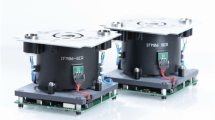Abstract
We assess the possibility of reducing the travel time of a crewed mission to Mars by examining four different propulsion methods and keeping the mass at departure under 2500 t, for a fixed architecture. We evaluated representative systems of three different state of the art technologies (chemical, nuclear thermal and electric) and one advance technology, the “Pure Electro-Magnetic Thrust” (PEMT) concept (proposed by Rubbia). A mission architecture mostly based on the Design Reference Architecture 5.0 is assumed in order to estimate the mass budget, that influences the performance of the propulsion system. Pareto curves of the duration of the mission and time of flight versus mass of mission are drawn. We conclude that the ion engine technology, combined with the classical chemical engine, yields the shortest mission times for this architecture with the lowest mass and that chemical propulsion alone is the best to minimise travel time. The results obtained using the PEMT suggest that it could be a more suitable solution for farther destinations than Mars.









Similar content being viewed by others
References
Ageyev, V.P., Ostrovsky, V.G., Petrosov, V.A.: High-current stationary plasma accelerator of high power. In: 23rd International Electric Propulsion Conference, Seattle, pp 1071–1075 (1993)
Amade, N.S., Wertz, J.: Design of a Mars rapid round trip mission. In: AIAA SPACE 2010 Conference & Exposition https://doi.org/10.2514/6.2010-8642, AIAA 2010-8642 (2010)
Astrium: Vinci rocket engine - thrust chamber. http://cs.astrium.eads.net/sp/launcher-propulsion/rocket-engines/vinci-rocket-engine.html, accessed 12 March 2012 (2012)
Bérend, N, Epenoy, R., Cliquet, E., Laurent-Varin, J., Avril, S.: Technological requirements of nuclear electric propulsion systems for fast Earth-Mars transfers. EUCASS Proceedings Series 4, 313–336 (2013). https://doi.org/10.1051/eucass/201304313
Bertolami, O., Pedro, F.G.: Gravity control propulsion: Towards a general relativistic approach. J. Brit. Interplanet. Soc. 60, 14 (2006). arXiv:https://arxiv.org/abs/physics/0610116
Bertolami, O., Tajmar, M.: Gravity control and possible influence on space propulsion: A scientific study. European Space Agency, ESA Publication Division, ESTEC. ESA CR(P) 4365 (2002)
Black, D.L., Cooper, L.H., Dickson, P.W., Stefanko, J.S., Kim, C.: Preliminary Study of the NERVA II Reactor Design. Tech. rep. National Aeronautics and Space Administration (1964)
Brophy, J., Gershman, R., Strange, N., Landau, D., Merrill, R., Kerslake, T.: 300-kW Solar Electric Propulsion System Configuration for Human Exploration of Near-Earth Asteroids. In: 47th AIAA/ASME/SAE/ASEE Joint Propulsion Conference & Exhibit. Joint Propulsion Conferences, American Institute of Aeronautics and Astronautics. https://doi.org/10.2514/6.2011-5514 (2011)
Brophy, J.R., Marcucci, M.G., Ganapathi, G.B., Garner, C.E., Henry, M.D., Nakazono, B., Noon, D.: The Ion Propulsion System for Dawn. In: 39Th AIAA/ASME/SAE/ASEE Joint Propulsion Conference and Exhibit. American Institute of Aeronautics and Astronautics, Joint Propulsion Conferences. https://doi.org/10.2514/6.2003-4542, pp 1–8 (2003)
Brown, C.D.: Spacecraft Mission Design, 2nd edn. American Institute of Aeronautics and Astronautics, Reston (1998)
Buden, D.: Nuclear rocket safety. Acta Astronaut. 18(C), 217–224 (1988). https://doi.org/10.1016/0094-5765(88)90102-6
Cassenti, B.N., Bass, R.W.: High risk low cost Mars missions scenarios. AIP Conference Proceedings 420(1), 1125–1130 (1998). https://doi.org/10.1063/1.54728
Conway, B.A.: Spacecraft Trajectory Optimization. Cambridge University Press, New York (2010)
Emcore: ZTJ photovoltaic cell datasheet. http://www.emcore.com/assets/photovoltaics/ZTJ_datasheet.pdf, accessed 12 March 2012 (2011)
Cucinotta, F.A., Schimmerling, W., Wilson, J.W., Peterson, L.E., Badhwar, G.D., Saganti, P.B., Dicello, J.F.: Space radiation cancer risks and uncertainties for Mars missions. Radiat. Res. 156(5), 682–688 (2001). https://doi.org/10.1667/0033-7587(2001)156[0682:SRCRAU]2.0.CO;2
Díaz, F., Carter, M.D., Glover, T., Ilin, A., Olsen, C., Squire, J.P., Litchford, R., Harada, N., Koontz, S.: Fast and robust human missions to Mars with advanced nuclear electric power and VASIMR® propulsion. In: Proceedings of Nuclear and Emerging Technologies for Space 2013, Albuquerque, NM, February 25-28, 2013, Paper 6777 (2013)
Drake, B.G., Hoffman, S.J., Beaty, D.W.: Human Exploration of Mars, Design Reference Architecture 5.0. In: 2010 IEEE Aerospace Conference, NASA Headquarters, IEEE. https://doi.org/10.1109/AERO.2010.5446736, vol. 10, pp 1–24 (2010)
Emhoff, J.W., Boyd, I.D.: Modeling of total thruster performance for NASA’s evolutionary xenon thruster ion optics. J. Propuls. Power 22(4), 741–748 (2006). https://doi.org/10.2514/1.18975
Erichsen, P.: Performance Evaluation of Spacecraft Propulsion Systems in Relation to Mission Impulse Requirements. In: Perry, M (ed.) European Spacecraft Propulsion Conference, ESA Special Publication, vol. 398, p 189 (1997)
Fletcher, K.: Mars Express: The Scientific Investigations. Tech Rep. ESA, Noordwijk (2009)
Fortescue, P., Stark, J., Swinerd, G.: Spacecraft Systems Engineering, 4th edn. Wiley, Hoboken (2011)
Gil, P.J.S., Teixeira, F.A.C.G.: Rapid Crewed Missions to Mars with Impulsive Thrust. In: 72Nd International Astronautical Congress 2021, IAC 2021, International Astronautical Federation, IAF, paper No. IAC-21.A5.2.12 (2021)
Graf, J.E., Zurek, R.W., Eisen, H.J., Jai, B., Johnston, M., DePaula, R.: The Mars Reconnaissance Orbiter mission. Acta Astronaut. 57(2-8), 566–578 (2005). https://doi.org/10.1016/j.actaastro.2005.03.043
Hughes, K.M., Edelman, P.J., Longuski, J., Loucks, M., Carrico, J.P., Tito, D.A.: Fast Mars free-returns via Venus gravity assist. In: AIAA/AAS Astrodynamics Specialist Conference, AIAA 2014–4109 (2014)
Kemble, S.: Interplanetary Mission Analysis and Design. Praxis Publishing, Berlin (2006)
Klein, M., Schroeder, R.W.: NERVA program requirements document (1970)
Lamarsh, J.R., Baratta, A.J.: Introduction to Nuclear Engineering, 3rd edn. Prentice Hall, Upper Saddle River (2001)
Landau, D., Longuski, J.: A reassessment of trajectory options for human missions to Mars. In: AIAA/AAS Astrodynamics Specialist Conference and Exhibit, AIAA 2004–5095 (2004)
Landau, D., Longuski, J., Aldrin, B.: Continuous Mars Habitation with a Limited Number of Cycler Vehicles. https://doi.org/10.2514/6.2006-6020, AIAA 2006-6020 (2006)
Landau, D.F., Longuski, J.M.: Trajectories for human missions to Mars, Part I: Impulsive transfers. J. Spacecr. Rocket. 43(5), 1035–1042 (2006). https://doi.org/10.2514/1.18995
Leiter, H.J., Killinger, R., Bassner, H., Müller, J, Kukies, R.: Development of the Radio Frequency Ion Thruster RIT XT - a Status Report. Tech Rep. Astrium GmbH, Munich (2001)
Miele, A.: Computation of optimal Mars trajectories via combined chemical/electrical propulsion, part 1: Baseline solutions for deep interplanetary space. Acta Astronaut. 55(2), 95–107 (2004). https://doi.org/10.1016/j.actaastro.2004.01.053
Nance, J.C.: Nuclear pulse propulsion. IEEE Trans. Nucl. Sci. 12(1). https://doi.org/10.1109/TNS.1965.4323511 (1965)
National Aeronautics and Space Administration: NASA’s evolutionary Xenon thruster. Briefing for New Frontiers AO (2008)
Nordley, G.D., Forward, R.L.: Mars-Earth rapid interplanetary tether transport system: I. initial feasibility analysis. J. Propuls. Power 17(3), 499–507 (2001). https://doi.org/10.2514/2.5798
Oberth, H.: Ways to Spaceflight. Tech. rep. NASA (1972)
Patel, M.R., Longuski, J.M., Sims, J.A.: Mars free return trajectories. J. Spacecr. Rocket. 35(3), 350–354 (1998). https://doi.org/10.2514/2.3333
Pelle, S., Gargioli, E., Berga, M., Pisacreta, J., Viola, N., Dalla Sega, A., Pagone, M.: Earth-Mars cyclers for a sustainable human exploration of Mars. Acta Astronaut. 154, 286–294 (2019). https://doi.org/10.1016/j.actaastro.2018.04.034
Portree, D.S.F.: Humans to Mars: Fifty Years of Mission Planning, 1950-2000. Tech Rep. NASA History Division, Washington DC (2001)
Price, H., Hawkins, A., Radcliffe, T.: Austere Human Missions to Mars. In: AIAA SPACE 2009 Conference & Exposition, American Institute of Aeronautics and Astronautics, Reston, VA. https://doi.org/10.2514/6.2009-6685 (2009)
Prince, J.L.H., Powell, R.W., Murri, D.: Autonomous aerobraking: a design, development, and feasibility study. In: Proceedings of the AAS/AIAA Astrodynamics Specialist Conference. Advances in the Astronautical Sciences Series, vol. 142, AAS 11-473 (2011)
Ranieri, C.L., Ocampo, C.A.: Indirect optimization of three-dimensional finite-burning interplanetary transfers including spiral dynamics. J. Guid. Contr. Dyn. 32(2), 445–455 (2009). https://doi.org/10.2514/1.38170
Pratt & Whitney Rocketdyne: Common extensible cryogenic engine (CECE). http://www.pw.utc.com/products/pwr/propulsion_solutions/cece.asp accessed 12 March 2012 (2009a)
Pratt & Whitney Rocketdyne: Rl10b-2. http://www.pw.utc.com/products/pwr/assets/pwr_rl10b-2.pdf, accessed 12 March 2012 (2009b)
Rubbia, C.: Nuclear Space Propulsion with a Pure Electromagnetic Thrust. Tech Rep. CERN, Geneva (2002)
Sankaran, K., Cassady, L., Kodys, a D, Choueiri, E.Y.: A survey of propulsion options for cargo and piloted missions to Mars. Ann. N. Y. Acad. Sci. 1017, 450–467 (2004). https://doi.org/10.1196/annals.1311.027
Snecma: PPS 1350-G stationary plasma thruster. http://www.safran-aircraft-engines.com/space-engines/satellites/pps-1350-g, accessed 12 March 2012 (2011)
Society, T.P.: Nuclear space initiative: A planetary society white paper. http://www.planetary.org/action/opinions/nuclear_propulsion%_0505.html (2005)
Tajmar, M., Bertolami, O.: Hyopthetical gravity control and possible influence on space propulsion. J. Propuls. Power 21(4), 692–696 (2005). https://doi.org/10.2514/1.15240
Teixeira, F.A.C.G., Gil, P.J.S.: Rocket equation with burn losses and propellant tanks jettison. J. Spacecr. Rocket. https://doi.org/10.2514/1.A35201 (2021)
Transportation, A.S.: Propellant tanks for spacecraft. www.space-propulsion.com, accessed 12 March 2012 (2010)
Turner, M.J.L.: Rocket and Spacecraft Propulsion: Principles Practice and New Developments, 3rd edn. Springer, Heidelberg (2008)
Vulpetti, G., Johnson, L., Matloff, G.L.: Solar Sails: a Novel Approach to Interplanetary Travel. Copernicus Books, New York (2008)
Wertz, J.R.: Interplanetary round trip mission design. Acta Astronaut. 55(3), 221–232 (2004). https://doi.org/10.1016/j.actaastro.2004.05.019
Wiesel, W.E.: Spaceflight Dynamics, 3rd edn. Aphelion Press, New York (2010)
Woods, W.D.: How Apollo Flew to the Moon, ext edn. Springer, New York (2011)
Wooster, P.D., Braun, R.D., Ahn, J., Putnam, Z.R.: Mission design options for human Mars missions. Mars 3, 12–28 (2007). https://doi.org/10.1555/mars.2007.0002
Wright, H.S., Oh, D.Y., Westhelle, C.H., Fisher, J.L., Dyke, R.E., Edquist, K.T., Brown, J.L., Justh, H.L., Munk, M.M.: Mars aerocapture systems study. Tech. rep., NASA/TM-2006-214522 (2006)
Zubrin, R., Wagner, R.: The Case for Mars: the Plan to Settle the Red Planet and Why We Must. The Free Press, New York (1996)
Acknowledgements
The work of Paulo J. S. Gil was supported by FCT, through IDMEC, under LAETA, project UIDB/50022/2020. The authors would like to thank John Brophy for helpful comments and suggestions on some issues of this manuscript. On behalf of all authors, the corresponding author states that there is no conflict of interest.
Author information
Authors and Affiliations
Corresponding author
Additional information
Publisher’s Note
Springer Nature remains neutral with regard to jurisdictional claims in published maps and institutional affiliations.
Rights and permissions
About this article
Cite this article
Guerra, A.G.C., Bertolami, O. & Gil, P.J.S. Comparison of Four Space Propulsion Methods for Reducing Transfer Times of Crewed Mars Missions. J Astronaut Sci 69, 284–311 (2022). https://doi.org/10.1007/s40295-021-00300-0
Accepted:
Published:
Issue Date:
DOI: https://doi.org/10.1007/s40295-021-00300-0




